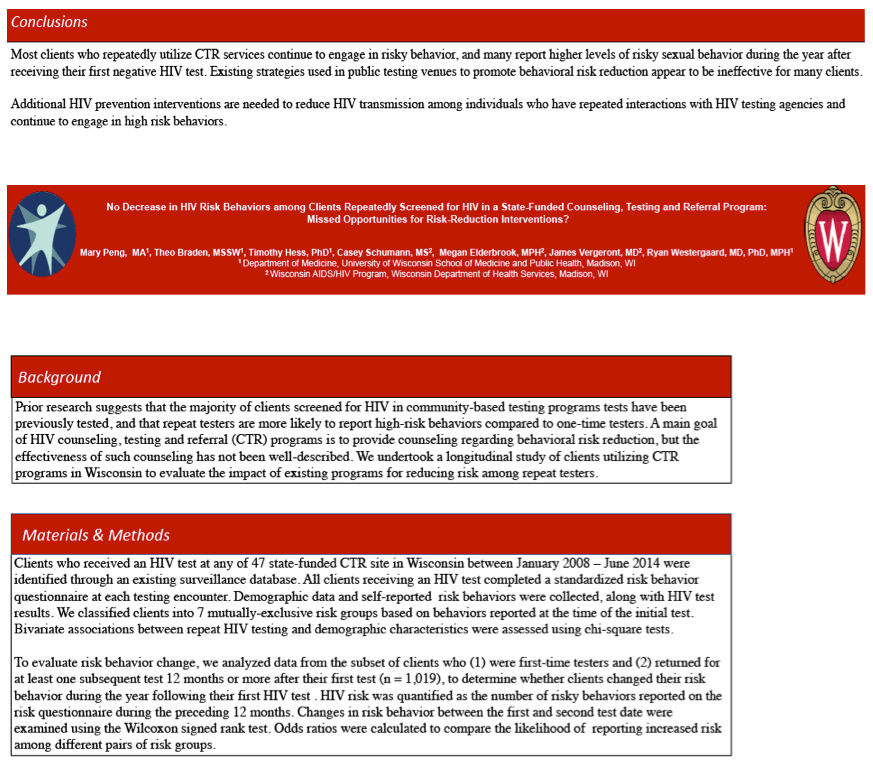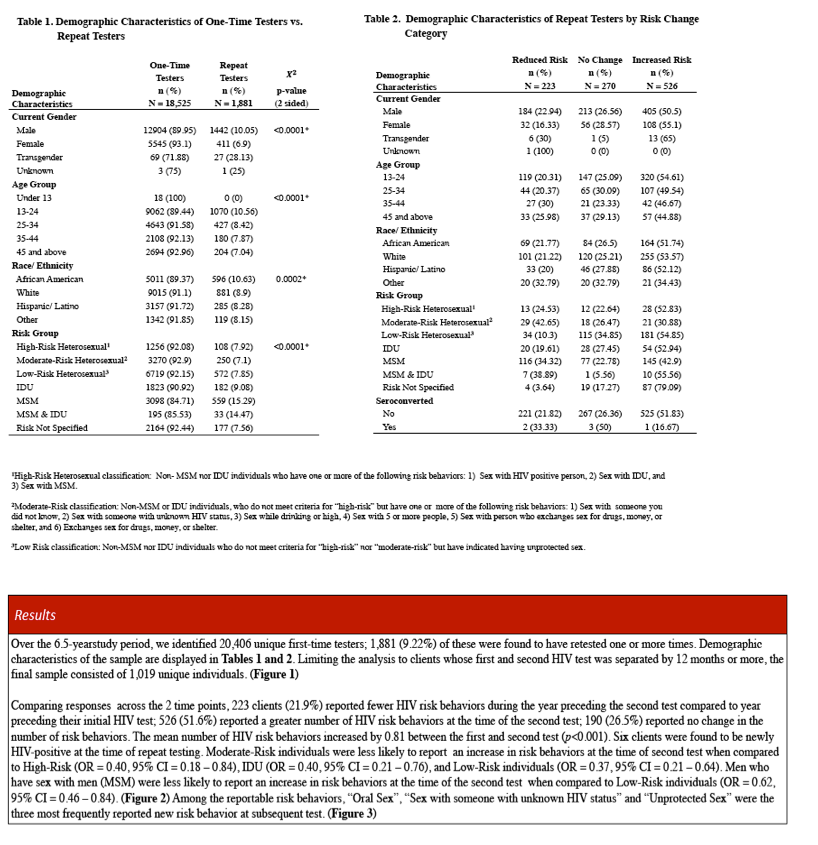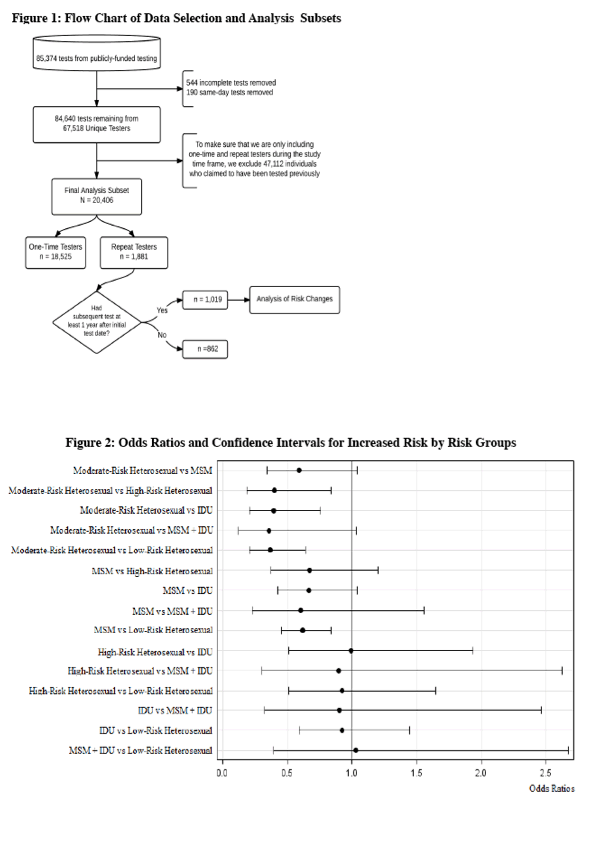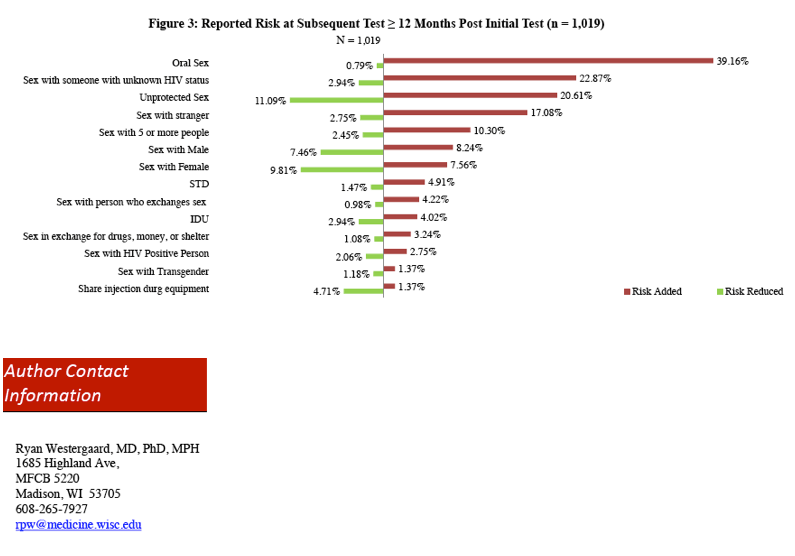 |
 |
 |
| |
HIV Risk Behavior Increases Between HIV Tests in Half of Wisconsin Group
|
| |
| |
IDWeek 2014, October 8-12, 2014, Philadelphia
Mark Mascolini
Self-reported HIV risk behavior increased between a first HIV test and a second test in 52% of a Wisconsin group using publicly funded counseling and testing [1]. Compared with other risk groups, moderate-risk heterosexuals and men who have sex with men (MSM) were more likely to report decreasing risk behavior from one counseling-and-testing session to the next.
A key goal of most HIV counseling-and-testing programs is to help people reduce future risk of HIV testing. But research indicates that repeat testers often report more risk behaviors than first-time testers. To determine changes in risk behaviors over a testing interval and reasons for those changes, University of Wisconsin investigators and colleagues at other institutions conducted this study.
The analysis involved people tested at any of 47 state-funded sites in Wisconsin from January 2008 through June 2014. Everyone completed a standardized questionnaire to give demographic data and to enumerate HIV risk behaviors in the preceding 12 months. The investigators divided tested people into seven mutually exclusive risk groups based on reported behaviors. All study participants were 13 or older.
To assess changes in risk behavior, the researchers focused on first-time testers who returned for one or more tests 12 or more months after the first test. The Wisconsin team quantified HIV risk by counting the number of risky behaviors reported in the risk questionnaire in the past 12 months.
The study involved 18,525 one-time testers and 1881 repeat testers, 70% and 77% of them male, 49% and 47% white, 27% and 32% African American, and 17% and 15% Hispanic. Among repeat testers, 108 were high-risk heterosexual*, 250 moderate-risk heterosexual, 572 low-risk heterosexual, 182 injection drug users (IDUs), 559 MSM, 33 MSM and IDU, and 177 with no specified risk.
Among 1019 people with a repeat test at least 12 months after their first test, the investigators determined that 223 (22%) reduced the number of HIV risk behaviors from their first test to their second, 270 (26%) did not change the number of risk behaviors, and 526 (52%) increased the number of risk behaviors. Among men, 51% increased their risk, 27% had no change, and 23% decreased their risk. Every age group analyzed had a higher proportion of who increased risk versus decreasing risk or making no change. Number of risk behaviors increased in 54% of whites, 52% of African Americans, and 52% of Hispanics.
Average number of HIV risk behaviors rose 0.81 between the first and second HIV test, a highly significant change (P < 0.001). The most frequently reported new risk behaviors were oral sex (39%), sex with someone of unknown HIV status (23%), sex without condoms (21%), sex with a stranger (17%), and sex with 5 or more people (10%).
MSM included a lower proportion of people with increased risk behavior (43%) than did high-risk heterosexuals (53%) or IDUs (53%) but not moderate-risk heterosexuals (31%). Moderate-risk heterosexuals and MSM were less likely to report increased risk behaviors at their second HIV test than some other groups, as indicated by the following odds ratios (OR) and 95% confidence intervals (CI):
-- Moderate-risk heterosexuals vs high-risk heterosexuals: OR 0.40, 95% CI 0.18 to 0.84
-- Moderate-risk heterosexuals vs low-risk heterosexuals: OR 0.37, 95% CI 0.21 to 0.64
-- Moderate-risk heterosexuals vs IDUs: OR 0.40, 95% CI 0.21 to 0.76
-- MSM vs low-risk heterosexuals: OR 0.62, 95% CI 0.46 to 0.84
One person (0.2%) with increasing risk behaviors, 3 (1.1%) with no change in risk, and 2 (0.9%) with decreased risk tested positive on their second test.
The researchers concluded that most study participants who had at least one follow-up HIV test continued to engage in high-risk behavior, and half of them increased risk behavior from their first HIV test to their second. They suggested that "existing strategies used in public testing venues to promote behavioral risk reduction appear to be ineffective for many clients."
Reference
1. Westergaard R, Peng M, Hess T, Schumann C, Elderbrook M, Vergeront J. No decrease in HIV risk behaviors among clients repeatedly screened for HIV in a state-funded counseling, testing and referral program: missed opportunities for risk-reduction interventions? IDWeek 2014. October 8-12, 2014, Philadelphia. Abstract 1530.
*High-risk heterosexuals are people who are not MSM or IDUs and report one or more of the following risk behaviors: sex with an HIV-positive person, sex with an IDU, or sex with an MSM. Moderate-risk heterosexuals do not meet the high-risk definition but report other risk behaviors. Low-risk heterosexuals do not meet the high-risk or moderate-risk definitions but report sex without condoms.




|
| |
|
 |
 |
|
|